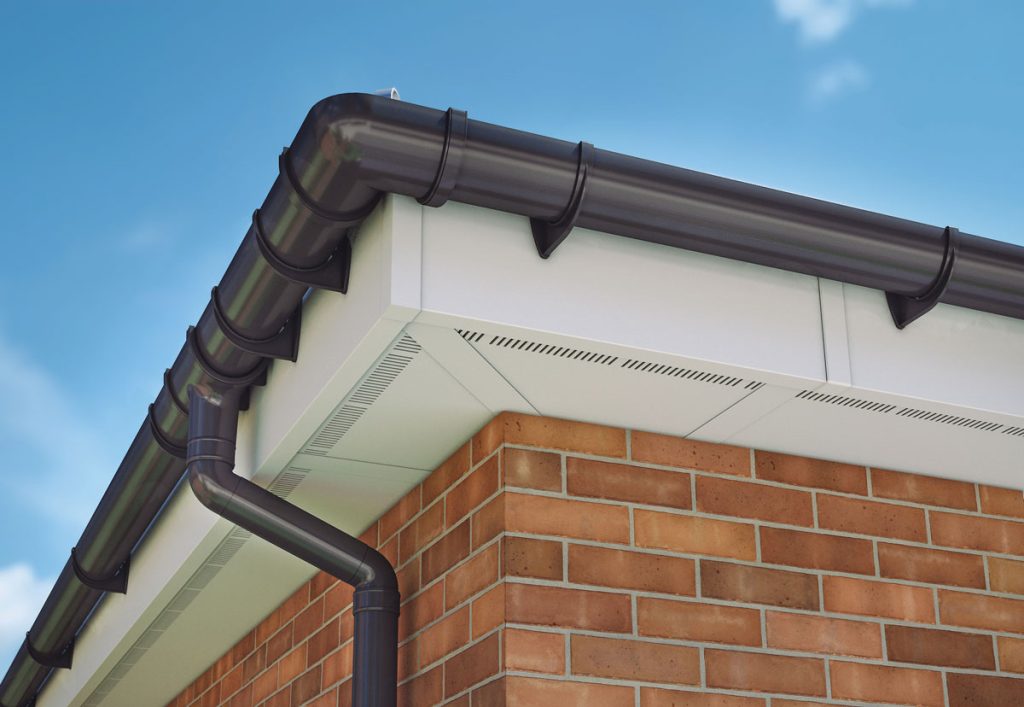Guttering is one of the most important aspects of your property.
If yours has started to sag or pull away from the fascia, or you’ve spotted cracks or water dribbling out of your downspouts every time it rains, then it’s time to look for a replacement.
There are many different materials and profile options available – all at various price points.
But how do you know which one to choose?
To help you make an informed decision, here we explain more about the different types of guttering on the market currently.
Guttering material options
PVC guttering
Plastic is a reliable yet low-cost guttering option.
It’s easy to install and capable of handling high volumes of water, which is perfect if you live in an area that receives a lot of rain.
Plastic guttering (particularly polyvinyl chloride or PVC for short) boasts a push-fit design that enables you to connect your system without any specialist knowledge or tools. It also makes replacing damaged sections quick and easy – saving you time and effort.
If you’re looking for a stronger alternative that offers better resistance to extreme weather conditions and UV exposure, consider a system that’s made from metal.
Cast iron guttering
Cast iron gutters are favored for their robustness and timeless look.
When installed correctly, this type of guttering can last up to 100 years – eliminating the need for frequent (and costly) replacements.
Cast iron also softens the sound of flowing water and offers excellent resistance to fire.
In terms of their appearance, these gutters can enhance the periodic charm of a property. They’re an equally attractive option for contemporary buildings, too, and can be used for new build, restoration, refurbishment and commercial projects.
Aluminium guttering
Due to its high strength and low density, aluminium is a popular guttering option that won’t take long to install – even if you’re no expert at DIY!
It’s a highly durable and weatherproof material that can last 25 years or more, providing you with outstanding value for money.
Aluminium guttering is not susceptible to rust and will not be impacted by thermal expansion. It’s less prone to cracks caused by sudden weather changes, too – making it ideal if the weather is unpredictable and temperatures fluctuate from one month to the next.
Copper guttering
If you’re looking for a stylish option, copper guttering is a serious contender.
This material adjusts to the environment and, over time, changes from rustic brown to bronze and then the green or blue patina, as a result of oxidation.
Whilst oxidation can be a bad thing for galvanised steel gutters, it ensures durability and corrosion resistance for copper guttering. It minimises the growth of moss and lichens, too, requiring less cleaning and maintenance.
Copper guttering can look great on contemporary and traditional buildings alike and it’s incredibly low maintenance. It doesn’t require painting – you simply need to remove debris occasionally to ensure optimal functionality.
Steel guttering
Steel guttering is a low maintenance system that’s lightweight and easy to install.
Galvanised steel provides additional strength and can resist thermal expansion and contraction.
When unpainted, galvanised steel gutters provide a contemporary look that’s perfect for modern-style properties. However, a special paint that won’t peel can be used to match most building styles.
Though they share several similarities, stainless steel gutters provide more rust resistance and require minimal cleaning to maintain their shine for longer. The only downside is that they are heavier (and slightly more expensive) than their galvanised counterparts.
Guttering profile options
Half-round gutters
The half-round guttering style is one of the most common available.
Providing a uniform profile with smooth curves to allow rainwater to flow, half-round gutters are perfect for both traditional and contemporary properties.
Ogee gutters
The ogee guttering (short for original gothic) style first became popular in the Victorian era and has been used on properties built after 1960.
An ogee gutter has a distinctive look and includes several curves, often referred to as an ‘S’ curve. Though typically suited to traditional buildings with period features, this type of guttering can add a touch of authenticity to modern buildings, too.
Deep gutters
If you like the half-round style of gutters but live in an area where rainfall or water runoff is higher than average, or you have a large or steep roof, consider deep-style guttering for your property.
These are very similar to half-round gutters but they have a deeper channel to hold more water – preventing it from overflowing.
Square gutters
For a contemporary look outside your property, opt for a square gutter (also known as a box or trough gutter) with a 3-sided rectangular channel.
This type of guttering boasts a straight and angular design which is best suited to contemporary apartments and outbuildings. Its deeper channel also makes it perfect for areas of high rainfall and buildings with large roof areas.
Which type of guttering is best for your project?
After finding out more about the different guttering options available, you should be in a better position to make a decision.
However, if you’re unsure or need an expert opinion, it’s worth contacting drainage specialists, like the team at Build Plumb Plastics.
They will be able to advise you on the most suitable guttering and downpipes for your property – taking into account your location and the amount of rainfall you receive, as well as your budget and style preferences.

